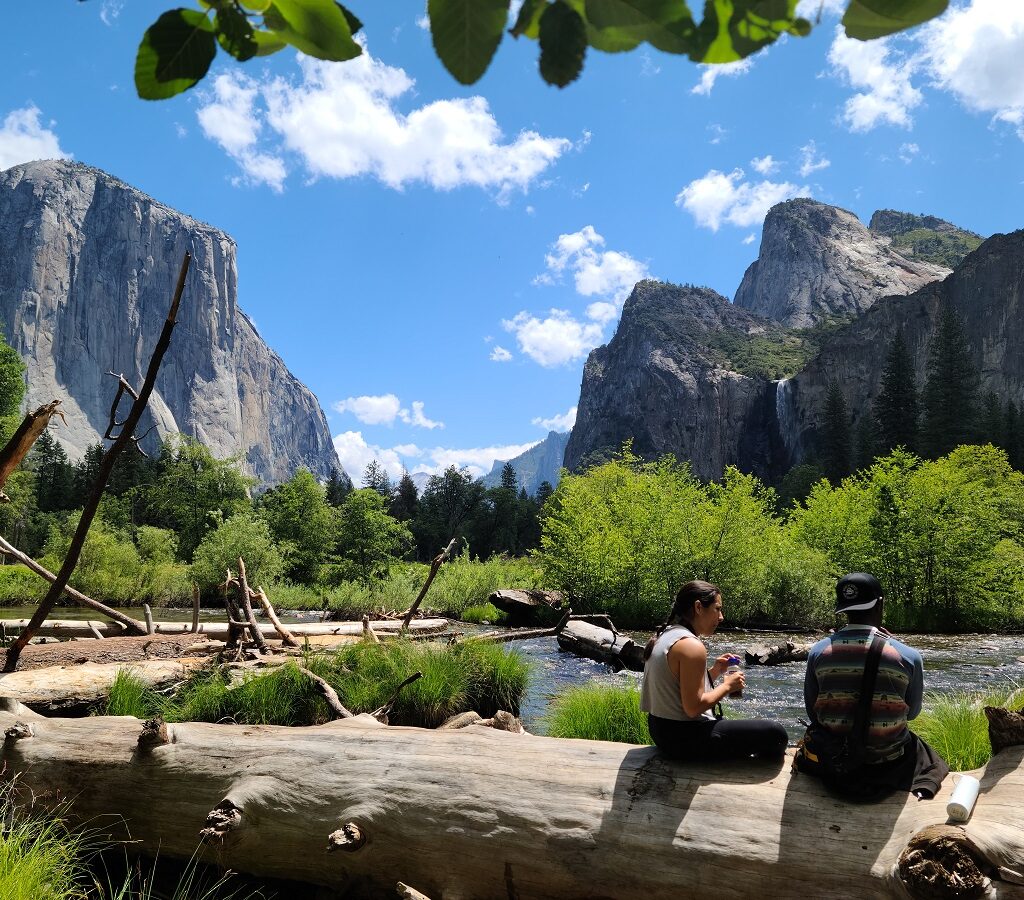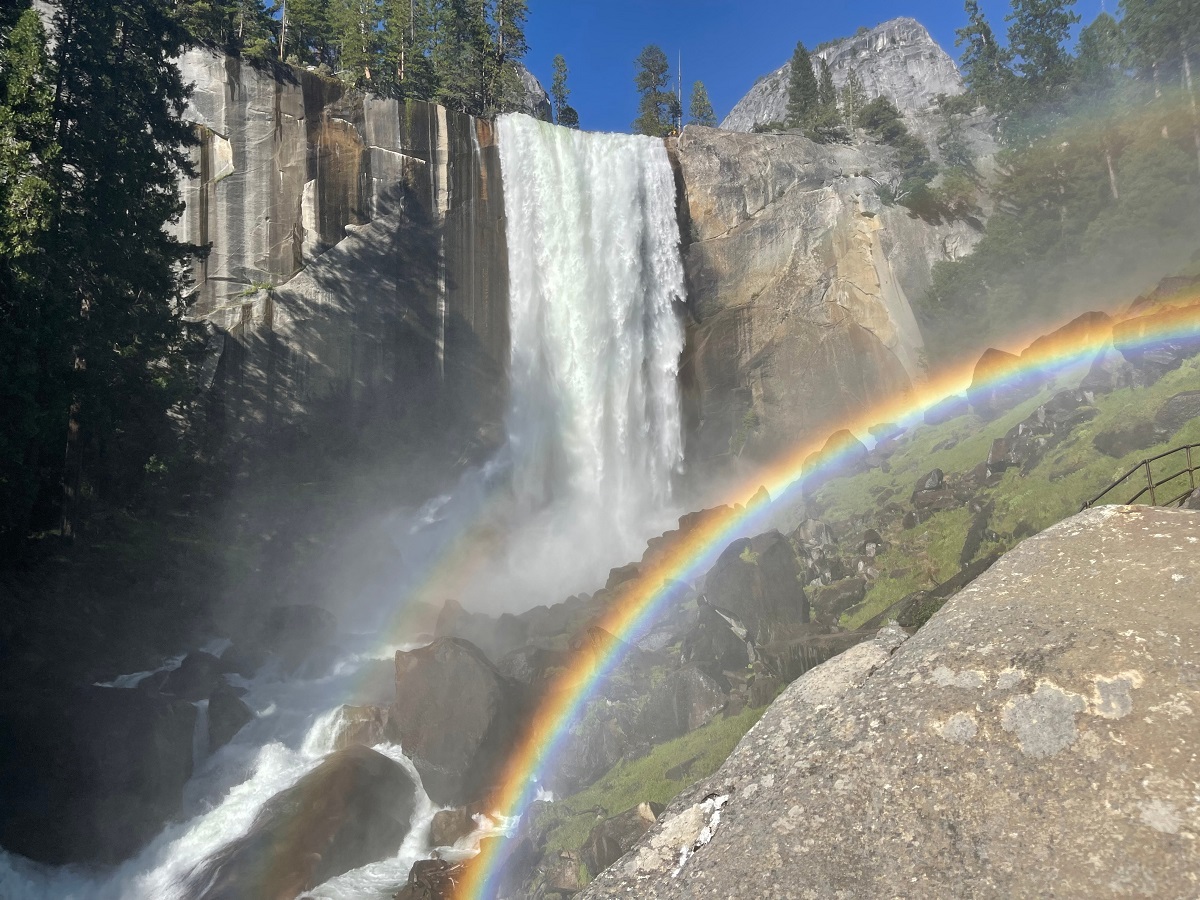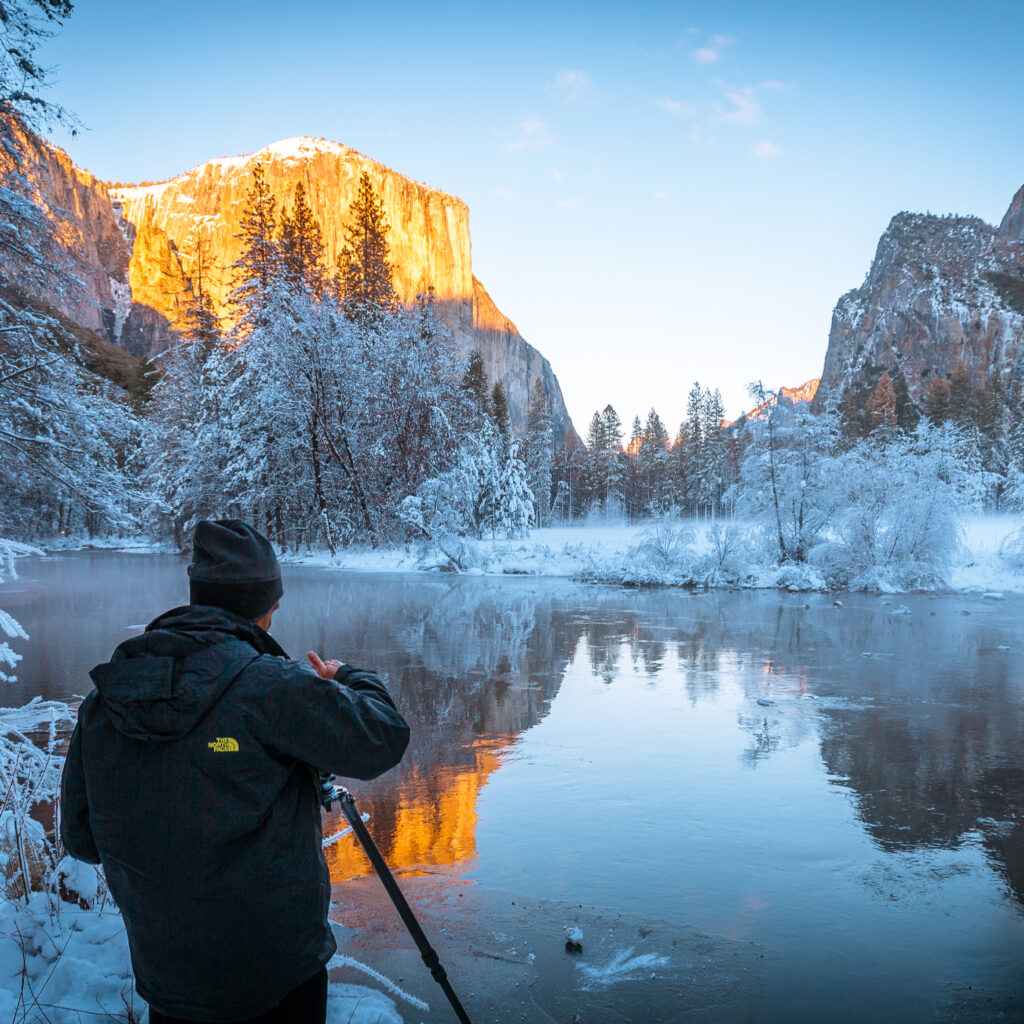Because the national park is open 24/7, 365 days a year, you can plan your visit to Yosemite in summer or winter. When the weather’s warm, Yosemite’s sun-drenched landscape is lush with rushing rivers, open access roads, and wildflowers in full bloom. Come winter, the park transforms into a frosted wilderness retreat, featuring winter sports activities and peaceful scenery. Both summer and winter have plenty to offer on a visit to Yosemite, from camping and stargazing to frosty nature walks, skiing, and snowshoeing.
In this guide, we cover what to expect when visiting Yosemite in summer or winter, along with the best things to do in each season so you can plan your trip for any time of year.

Visiting Yosemite National Park in Summer
Yosemite is absolutely worth visiting in summer, when the park is at its most vibrant. Waterfalls surge, trails are open from valley floor to alpine peak, and long daylight hours invite extended exploration. Summer is the most popular time of year for camping in Yosemite, and it is typically the season with the biggest crowds. Here’s what to expect:
- Rain is rare in Yosemite in the summer, so expect warm, sunny days with average temps anywhere between the 70s to 90s, depending on elevation.
- Nighttime temps typically average in the 40s—cool and comfortable for camping under open skies.
- Anticipate peak crowds from June through August. We suggest making lodging reservations in advance and getting an early start on your adventures to avoid crowded landmarks.
- Most of the park’s trails and roads are fully open during summer, letting you explore the far corners of what Yosemite has to offer.
- Although the park is always open in summer and winter, some entrance stations have restricted hours. For example, the Hetch Hetchy gate is only open during daylight hours.

Top Things To Do in Yosemite in Summer
Summer is when Yosemite National Park is most accessible and alive. Here are some of our favorite things to do:
- Drive to Glacier Point and Tioga Road: Get swept away by the stunning beauty of the alpine lakes and wildflower meadows. Glacier Point is only accessible in late spring and summer.
- Chase Waterfalls: See Yosemite Falls, Bridalveil Fall, and Vernal Fall at their fullest in early summer.
- Explore Yosemite Valley by Bike or Shuttle: Enjoy iconic views of Half Dome and El Capitan without the parking stress.
- Trek Yosemite’s Iconic Trails: The Mist Trail, Yosemite Falls Trail, or Panorama Trail offer some of the best hikes in Yosemite in summer.
- Go Rock Climbing or Bouldering: Experience Yosemite’s world-famous granite, or watch climbers scale El Capitan. Summer climbers typically start early or wait until evening to avoid midday heat.
- Cool Off in the Merced River: Swim, wade, or raft along gentle river sections that flow through Yosemite Valley.
- Camp or Picnic Under the Stars: Warm nights and clear skies make for perfect evenings outdoors.
- Go Wildlife Watching: Get in touch with your wild side and bring the camera to catch shots of bobcats, mule deer, black bears, and other long-term residents of the park.
- Capture a Panorama: Photograph the golden glow from Tunnel View or Sentinel Dome. In summer, the park is picture-pretty anywhere you look.

Visiting Yosemite National Park in Winter
In winter, Yosemite becomes a snowy wonderland of cozy lodges, frozen waterfalls, and smaller crowds, and the season invites a slower pace for exploration and reflection. Trails in Yosemite Valley stay open for crisp, peaceful walks, while higher elevations transform into playgrounds for snowshoeing, skiing, and photography. Wondering how to visit Yosemite in winter? The first step is knowing what to expect:
- Through winter, daytime temperatures often range from the 30s to 50s, dipping below freezing at night.
- Prepare for snow. Winter is when 75% of Yosemite’s precipitation falls, and mostly in the form of snow.
- Many valley trails stay open for hiking, but visitors should note that Tioga Road closes for the season and Glacier Point Road is closed to vehicles past the Badger Pass Ski Area.
- Yosemite Valley remains open year-round, with plowed roads, clear signage, and easy access to many of the park’s most iconic lookouts.
- Although it is less crowded than in summer, it’s still a good idea to book Yosemite winter lodging in advance, particularly ahead of weekends and holidays.

Top Things To Do in Yosemite in Winter
There’s no shortage of ways to experience the park’s magic when it’s cold. Here are some of the best things to do in Yosemite in winter:
- Go Snowshoeing or Cross-Country Skiing: Explore peaceful trails around Merced Grove, Tuolumne Grove, and cross-country skiing at Crane Flat for a one-of-a-kind winter experience.
- Try Downhill Skiing or Snowboarding: Hit the slopes at Badger Pass, California’s first ski area, with runs suited for all skill levels.
- Take a Winter Hike: Enjoy lower-elevation trails in Yosemite Valley. Mirror Lake, Lower Yosemite Fall, or Cook’s Meadow Loop are a few of the best hikes in winter — ideal for crisp, scenic walks.
- Make Camp: Grab your warmest sleeping bag because you can camp in Yosemite even in winter. Select campgrounds are open through the winter season, though many are first-come, first-served, or require reservations.
- Capture Yosemite Waterfalls in Winter: Photograph the dramatic icy spray of Bridalveil Fall or the misty power of Yosemite Falls framed by snow. February is also the only time of year you can see the spectacular Firefall.
- Visit Tunnel View or Valley View: These iconic overlooks are especially striking with snow-dusted granite cliffs and low winter light.
- Watch for Wildlife: Spot deer, coyotes, and birds adapting to the colder season. They’re often easier to see with fewer crowds around.
- Ice Skate at Curry Village: Glide beneath the granite walls of Half Dome at this classic seasonal rink.
- Join a Guided Program: Learn about Yosemite’s winter ecology, wildlife, and geology through guided snowshoe walks and talks.
Planning Your Visit in Summer or Winter
There’s no best time of year to visit Yosemite because each season has something special to offer. Summer brings energy, accessibility, and long days filled with sunshine and adventure — perfect for hikers, families, and first-time visitors. Winter offers quiet beauty, snowy landscapes, and a sense of solitude that’s rare in such an iconic place. Both seasons reveal Yosemite’s character in distinct ways, inviting you to decide whether you want to feel the park’s pulse or its peaceful stillness.
No matter when you visit, Yosemite’s beauty never takes a season off. Contact us to start planning your trip today, and let Yosemite Hotels show you just how unforgettable every season can be.

